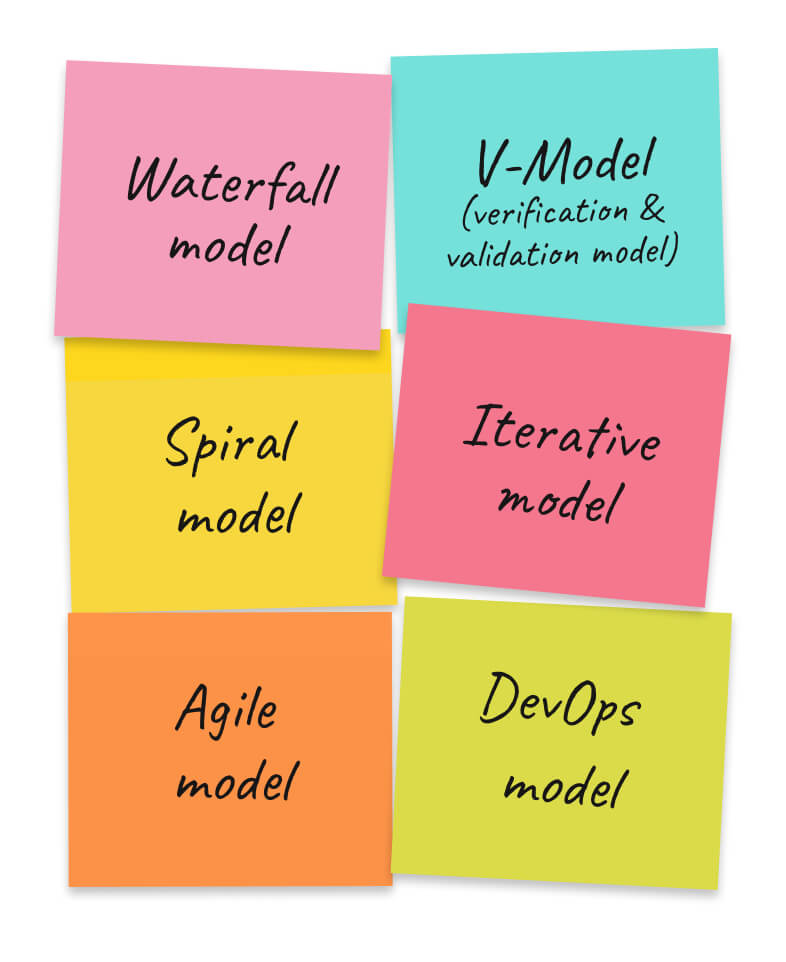

A global team of technologists, strategists, and creatives dedicated to delivering the forefront of innovation. Stay informed with our latest updates and trends in advanced technology, healthcare, fintech, and beyond. Discover insightful perspectives that shape the future of industries worldwide.
Software Development Life Cycle Explained
A software project requires careful planning, execution, and maintenance to ensure sustained functionality, efficiency, and scalability. The software development life cycle (SDLC) is a method that guides developers and project managers through a systematic approach to building software.
- Software development life cycle: Phases
- Planning and requirement analysis
- System design
- Implementation (coding and development)
- Testing and quality assurance
- Deployment and release management
- Maintenance and continuous improvement
- Software development life cycle: Models
- Waterfall model
- V-Model (verification and validation model)
- Iterative model
- Spiral model
- Agile model
- DevOps model
- 10Pearls can help with SDLC phases and models
The SDLC has six primary phases: planning, design, implementation, testing, deployment, and maintenance. A well-defined SDLC reduces risks, improves software quality, and speeds up software development. This article explains each phase, highlights best practices and tools, and compares SDLC models.
Software development life cycle: Phases


1. Planning and requirement analysis
Planning is the first step in the SDLC. This process includes defining the project’s scope, goals, feasibility, budget, and timeline. In this phase, stakeholders such as business analysts, project managers, and clients work together to establish clear goals.
Best practices
- Hold meetings with stakeholders and define goals.
- Use requirement-gathering techniques such as interviews, surveys, and brainstorming sessions.
- Prioritize requirements using the MoSCoW (Must-have, Should-have, Could-have, Won’t-have) method.
- Document functional and non-functional requirements in a software requirement specification (SRS) document.
Tools like JIRA, Trello, and Confluence can help with the planning and requirements analysis phase.
2. System design
As soon as the requirements are clear, the system design phase begins. This phase turns business requirements into technical specs for developers to follow. System design includes architecture, database schema, user interface, and security.
Best practices
- Choose the appropriate software architecture (for example, Monolithic or Microservices).
- Design modular components to improve maintainability and scalability.
- Use unified modeling language (UML) diagrams to visualize system components.
- Prioritize security best practices, such as threat modeling and data encryption.
Figma and Adobe XD help with UI design, Enterprise Architect and Visual Paradigm assist with system modeling, and MySQL Workbench and ER/Studio aid in database design.
3. Implementation (coding and development)
In the implementation phase, code is written based on design specs. Coding standards, version control, and agile development methods guarantee high-quality code.
Best practices
- Follow coding standards (for example, PEP8 for Python, Google Java Style Guide).
- Employ Agile methodologies like Scrum or Kanban for iterative development.
- Apply version control using Git, following branching strategies (for example, GitFlow).
- Perform code reviews and encourage pair programming for quality assurance.
Version control tracks changes and facilitates team collaboration. It’s best to use Git with GitHub, GitLab, or Bitbucket repositories and branching strategies like GitFlow. Maintaining consistency is easier with containerization tools like Docker and Kubernetes.
4. Testing and quality assurance
Testing software ensures it has no defects, meets functional requirements, and runs well under different conditions. During this phase, different levels of quality assurance (QA) occur:
QA testing types
| Type | Description |
| Unit testing | Checks individual components |
| Integration testing | Makes sure everything works together |
| System testing | Assesses the software as a whole |
| User acceptance testing | Ensures the software meets users’ expectations |
| Performance & Security Testing | Evaluates speed, scalability, and vulnerability |
- Follow a test-driven development (TDD) or behavior-driven development (BDD) approach.
- Automate repetitive tests.
- Maintain comprehensive test cases and documentation.
Using tools like JUnit and Selenium improves QA efficiency and accuracy. Cypress is good for automation. JMeter and LoadRunner are for performance testing. SonarQube and OWASP ZAP are good for security testing.
5. Deployment and release management
As soon as the software passes testing, it is deployed into a production environment, making it available to end users. Having a structured deployment strategy ensures a smooth transition with minimal downtime.
- Use continuous improvement/continuous delivery (CI/CD) pipelines.
- Implement canary releases or blue-green deployments to minimize downtime.
- Execute rollback strategies in case of deployment failure.
- Ensure thorough post-deployment monitoring.
Monitoring and logging are essential post-deployment to catch problems early. GitHub Actions, Jenkins, and CircleCI automate deployment processes. Datadog, New Relic, and Prometheus provide system monitoring capabilities.
6. Maintenance and continuous improvement
Software deployment initiates the maintenance and continuous improvement phase, where software is kept up-to-date, secure, and functional. Maintenance includes bug fixes, performance improvements, security patches, and feature enhancements.
Best practices
- Establish a bug-tracking system for prompt resolution.
- Schedule regular software updates and security patches.
- Monitor application logs to detect anomalies and failures.
- Collect user feedback for CI/CD.
Maintenance tools include: Sentry and LogRocket for error tracking; Postman and Swagger for API monitoring; and Nagios and Grafana for system monitoring.
A structured SDLC is essential to delivering high-quality, scalable, and maintainable software. Organizations can minimize risks, enhance efficiency, and meet user expectations by following a systematic approach—from planning and analysis to design, implementation, testing, deployment, and maintenance. Following best practices and using modern tools increases software project success rates.
Software development life cycle: Models


There are different SDLC models, and each one has its strengths and weaknesses. The right SDLC model depends on project complexity, timeline, flexibility, and risk management. Here are some common SDLC models:
Waterfall model
The waterfall model is a sequential model in which each phase is completed before proceeding to the next. The SDLC model is one of the most popular and suitable for software projects with well-defined requirements.
Advantages
- Simple and easy to manage.
- Clearly defined phases and deliverables.
- Works well for projects with stable requirements.
Disadvantages
- Inflexible—changes are difficult to implement once a phase is completed.
- Testing occurs late, increasing the risk of defects.
- Not suitable for complex or rapidly evolving projects.
Best suited for
- Small to medium-sized projects with clear, fixed requirements.
- Projects where changes are unlikely during development.
- Government and regulatory projects that require detailed documentation.
V-Model (verification and validation model)
The V-Model extends the Waterfall model because it requires testing during each development phase.
Advantages
- Early detection of defects through parallel testing.
- Clear structure and well-defined validation steps.
- Reduced project risks.
Disadvantages
- Rigid and not adaptable to requirement changes.
- High documentation overhead.
- Testing dependence on the initial requirements—if requirements change, entire phases must be redone.
Best suited for
- Projects where testing is critical (for example, healthcare, aerospace, and financial applications).
- Software requiring high reliability and minimal defects.
Iterative model
Iterative software development breaks down software development into small cycles, allowing incremental improvements over time. Unlike Waterfall, it allows for partial implementation and evolving requirements.
Advantages
- Allows early delivery of a working product.
- Reduces risks by addressing issues in smaller cycles.
- More flexible and easier to adapt to changes.
Disadvantages
- Requires more management and planning to track multiple iterations.
- Can lead to scope creep if changes are uncontrolled.
Best suited for
- Large projects where requirements are not fully defined at the start.
- Software requiring gradual enhancements and feedback-driven development.
Spiral model
The spiral model combines elements of the Iterative and Waterfall models with a focus on risk assessment. It has multiple loops, each acting as a phase in the SDLC.
Advantages
- Excellent for high-risk projects (for example, banking and defense).
- Incorporates continuous user feedback.
- Reduces risks through early prototyping.
Disadvantages
- Expensive and time-consuming due to risk assessments.
- Requires skilled project management to balance iterations.
- Not suitable for small projects with tight budgets.
Best suited for
- Large, high-risk projects that require continuous risk management.
- Software requiring frequent user feedback and security-sensitive applications.
Agile model
The Agile model emphasizes collaboration, adaptability, and incremental delivery. It uses Scrum, Kanban, or XP methodologies for small, frequent software releases.
Advantages
- Highly flexible—accommodates changing requirements.
- Increases customer satisfaction through frequent updates.
- Encourages teamwork and communication.
Disadvantages
- Requires constant collaboration and commitment.
- Difficult to estimate cost and time precisely.
- Less suited for fixed-budget projects with strict deadlines.
Best suited for
- Projects requiring CI/CD and adaptability.
- Startups, SaaS products, and fast-paced development teams.
- Projects with uncertain or evolving requirements.
DevOps model
The DevOps model integrates development and operations teams for CI/CD and continuous testing. It focuses on automation, monitoring, and collaboration to improve software quality and reduce release cycles.
Advantages
- Faster delivery with automated CI/CD pipelines.
- Improves software reliability and security through continuous monitoring.
- Enhances collaboration between development and operations teams.
Disadvantages
- Requires cultural and process changes within organizations.
- Needs expertise in automation tools.
- Not ideal for small teams without automation resources.
Best suited for
- Cloud-based applications and high-speed development environments.
- Large enterprises needing frequent deployments.
- Teams prioritizing automation and monitoring.
10Pearls can help with SDLC phases and models
Software development companies like 10Pearls can help businesses through the entire SDLC process, from ideation to deployment and maintenance. In the planning and discovery phase, we discuss your business goals, user needs, and technical requirements. Then, we conduct market research, feasibility analysis, and stakeholder meetings to ensure the project meets your needs. A well-structured software development roadmap starts here.
In the design phase, 10Pearls uses cutting-edge technologies and agile methodologies to create user-centric and scalable software solutions. Our designers create intuitive interfaces, while our developers build robust backend and frontend systems using the latest frameworks. We incorporate feedback to improve efficiency and functionality. We use DevOps practices, automated testing, and CI/CD to ensure high-quality code and faster time-to-market.
With 10Pearls, you can innovate confidently, reduce time to market, and stay competitive. With our expertise in emerging technologies like artificial intelligence, blockchain, and Internet of Things, clients can build solutions for the future.
Ready to get started?
With 10Pearls, you’re partnering with an innovative, client-centered company with the technical expertise to deliver exceptional results. We’re adaptable, we accommodate diverse business needs, and we consistently deliver value. We can help you navigate the software development life cycle. That’s why 10Pearls is the best choice when you need to outsource a dedicated software development team.

Get in touch with us
Related articles


